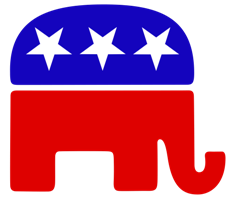How Big Will the 2024 GOP Presidential Field Get?
More Republican candidates will have launched bids by the end of the first week of June than in any previous election cycle in party history
 For all the talk by Republican officeholders and conservative political commentators leading up to the 2024 cycle that the best chance the GOP had to nominate a candidate other than Donald Trump was to limit the size of the field to a one-on-one battle, the number of hopefuls will have quietly risen to double digits – and a record pace – by the end of the first week of June.
For all the talk by Republican officeholders and conservative political commentators leading up to the 2024 cycle that the best chance the GOP had to nominate a candidate other than Donald Trump was to limit the size of the field to a one-on-one battle, the number of hopefuls will have quietly risen to double digits – and a record pace – by the end of the first week of June.
While Florida Governor Ron DeSantis still boasts the strongest poll numbers outside of Trump, his position has seemingly not been considered strong enough to ward off other hopefuls.
Many current candidates will no doubt end their campaigns long before the first primaries are conducted, but the total number of Republicans launching bids this cycle will ultimately rival the party’s largest field in history.
The current Republican field of announced candidates includes Trump, five sitting or former statewide officeholders (former South Carolina Governor Nikki Haley, former Arkansas Governor Asa Hutchinson, former Montana Secretary of State Corey Stapleton, South Carolina U.S. Senator Tim Scott, and the aforementioned DeSantis), plus two prominent candidates from the private sector (business executive Vivek Ramaswamy and talk show host Larry Elder).
Those eight candidates will be joined early next week by three others: former New Jersey Governor Chris Christie, former Indiana Governor and Vice President Mike Pence, and sitting North Dakota Governor Doug Burgum.
That will bring the GOP field to 11 candidates – the largest number of Republicans ever to announce at this stage of the election cycle.
Since 1972, the most Republicans to run for president were the 17 candidates who launched bids in 2016. A dozen Republicans ran in 2000, 2008, and 2012 with 11 in 1996.
However, none of those cycles saw as many candidates already on the trail by the end of the first week of June.
Ten candidates had entered the race by that point in 2008 and 2016, eight in 1996 and 2000, and seven in 2012.
It is also extremely unlikely that the Republican field will be capped at 11 candidates this cycle following the announcements of Pence and Burgum on Wednesday.
New Hampshire Governor Chris Sununu has perhaps been making the most waves, appearances, and talk show rounds of any of the not-as-yet announced candidates.
As some candidates drop out of the race after failing to gain traction and burning through their campaign finances, it is difficult to think other prominent Republicans will not replace them as late as August or even into the autumn.
And so, when the final count is conducted, the 2024 cycle will likely be at least the second largest field in party history and could rival the 2016 field that Trump won the first time around.
[It should be noted that anti-Trump fervor (and, perhaps, overcompensating for the premature crowning of nominee Hilary Clinton four years prior) saw a record two-dozen Democrats file for the office at this point of the 2020 election cycle].
UPDATE: On Monday, June 5th, Governor Sununu announced he would not seek the GOP nomination because the “crowded field” could hand the nomination to a candidate with 35 percent support and that the “stakes are too high” for that to happen. [Sununu has been a critic of Trump].
Follow Smart Politics on Twitter.

Is Burgum the first major-party presidential candidate from North Dakota?
[The ‘major-party’ qualifier is necessary because North Dakota’s Rep. William Lemke ran as the nominee of the short-lived Union Party in the 1936 election, winning 2% of the vote nationwide and 13% of the vote in his home state.]
We are on the same wavelength here – that question will be answered definitively in my next post – hopefully by mid-week.
[…] president at this early stage of the race than in any previous cycle in the history of the party, according to analysis from Eric Ostermeier, a research fellow at the University of […]
[…] How Big Will the 2024 GOP Presidential Field Get? […]